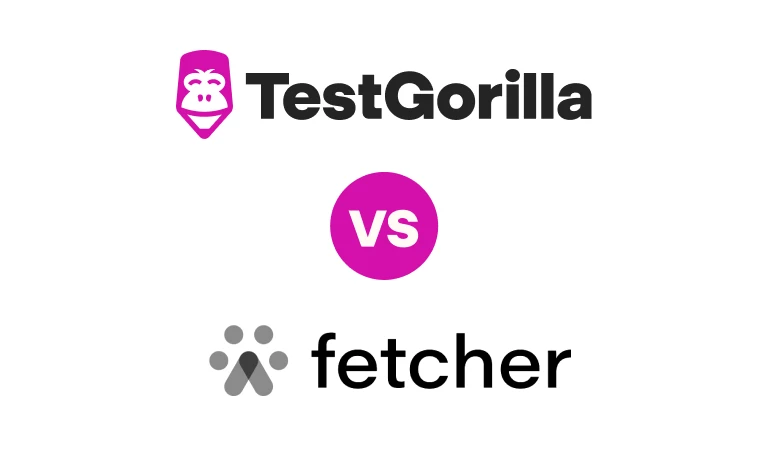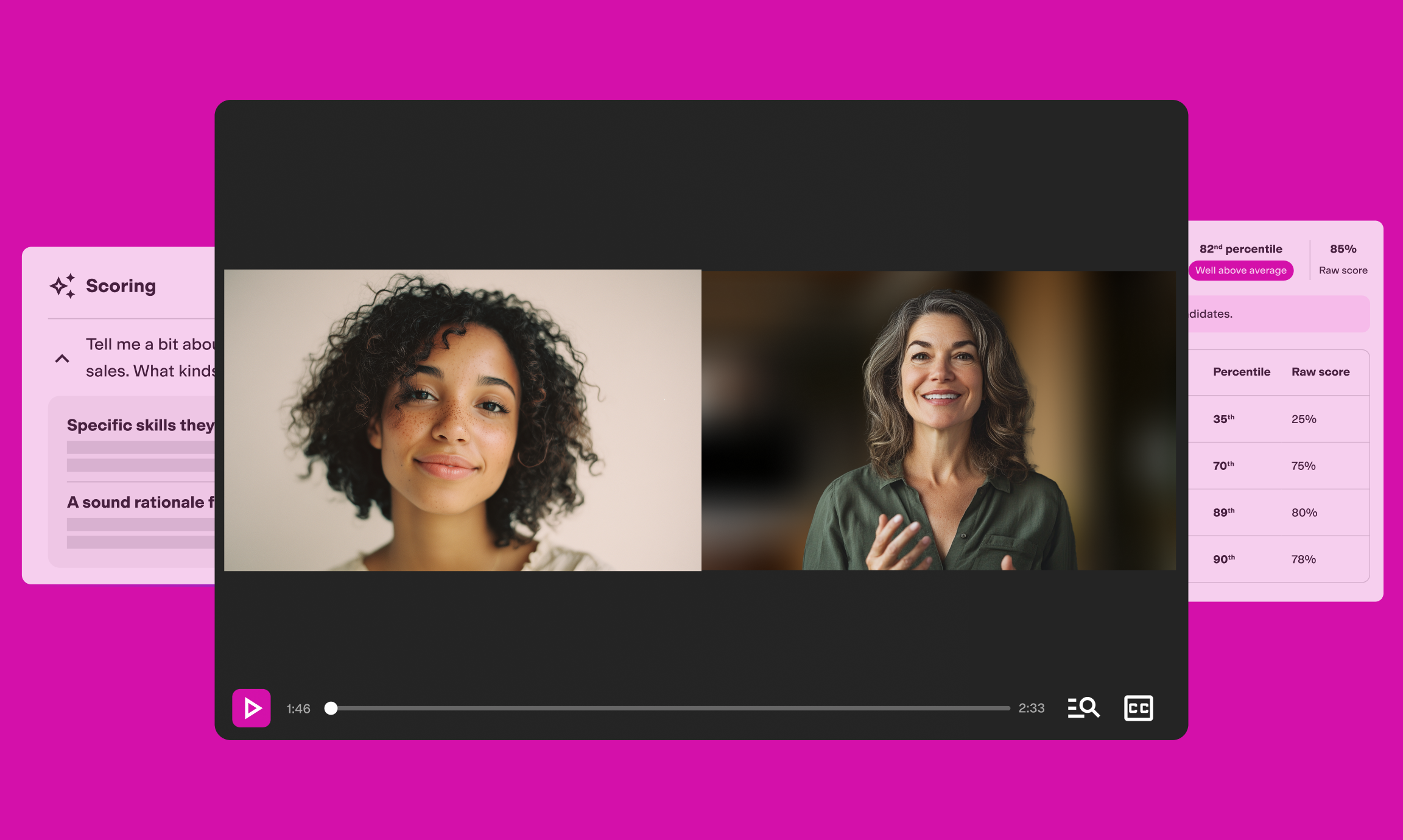What are interview scorecards? (Plus pros, cons, and a template)
Trying to evaluate a candidate during a short interview accurately can be tricky. With so many qualities and skills to assess, how can you be sure you’re making the right call? Evaluating candidates with interview scorecards can help.
Interview scorecards can increase consistency, improve decision-making, and enhance documentation during the interview process. However, the rigidity of a scorecard can sometimes make you overlook the intangible qualities of your perfect candidate: soft skills, communication style, and culture fit. These factors often don’t fit neatly into the boxes of an interview scorecard.
In this guide, we explore what interview scorecards are, their benefits and drawbacks, best practices for using them, and ways to combine them with pre-employment testing for an effective interview process.
Table of contents
- What is an interview scorecard?
- Example interview scorecard template
- Using an interview scorecard
- Benefits of interview scorecards
- Drawbacks of interview scorecards
- Interview scorecard: Best practices
- The best candidates aren’t always the best interviewers
- Get the most out of interview scorecards with TestGorilla
What is an interview scorecard?
An interview scorecard is a document used to score candidates during the interview process. It’s a structured way to measure a candidate’s interview answers and compare them to a predetermined set of ideal candidate qualities. Interview scorecards can reduce bias in the recruitment process and ensure all interviews are well documented.
You should create interview scorecards when you create your interview questions, as the two should align.
Example interview scorecard template
Creating an interview scorecard from scratch can take time and effort. To get started quickly, check out this free interview scorecard template.
The best insights on HR and recruitment, delivered to your inbox.
Biweekly updates. No spam. Unsubscribe any time.
Using an interview scorecard
Before the interview begins, identify the key qualities needed for the role. For example, a software engineer should be good at organization, problem-solving, and coding. However, their public speaking skills or creativity may not be as important. Create an overarching list of your ideal candidate’s knowledge, experience, skills, and other qualities.
Then, determine which interview questions you can use to assess each criterion. Use different types of interview questions to measure the various qualities you listed earlier. For example, the first few questions might assess experience by asking candidates about previous roles. Later, you could use situational interview questions to assess problem-solving abilities.
Assess your criteria across interview questions. Test for two to three criteria per question, and don’t be afraid to assess the same criterion using a few different questions. This way, you give the candidate more than one opportunity to demonstrate that they possess the quality associated with that criterion.
During the interview, score each question based on how well the candidate’s answer matches the criteria that question was looking for.
For example, if your first question is “Tell me a little about your background,” your scorecard might assess the response for evidence of the candidate’s openness, passion, and technical qualifications. A candidate who proves they have a qualified background, passion for the role, and strong reasoning for choosing their career path will likely score well.
At the end of the interview, add up the criteria scores, divide that number by the total number of points available, and multiply by 100 to get the candidate’s percentage score. You should strongly consider the candidate with the highest score for the job.
(Candidates total score / Total points available) x 100 = X%
There are several approaches to using interview scorecards. We recommend the approach described above because it’s completely customizable to the needs of your hiring process and can be changed easily.
Benefits of interview scorecards
Interview scorecards can help you make meaningful hiring decisions. The benefits of using scorecards include:
Improved consistency
Consistently scoring all candidates against the same criteria ensures that each candidate is subject to a fair and objective interview process.
This is important from both a legal and ethical standpoint. For example, if your business is accused of discriminatory hiring practices, proving that you follow a fair and consistent process could prevent a lawsuit.
Better decision-making
Using a simple scoring guide during interviews, like a 1-5 point-based system, helps you make fair, data-driven hiring decisions. This objective scoring method enables you to score candidate answers based on the qualifications they prove to have.
Once the interviews conclude, you calculate the scores, and those who score the highest are strong candidates to consider for the position. This consistency ensures fairness during the interview process and helps reduce bias.
Better feedback for candidates
Taking notes and scores during interviews enables you to give high-quality feedback to unsuccessful candidates. Feedback helps candidates in their employment journeys and strengthens your employer brand among job-seekers.
Effective documentation
Scorecards serve as records of the interview process. This documentation can be valuable for future reference, candidate feedback, audit purposes, and post-hiring analysis.
Drawbacks of interview scorecards
While there are benefits to using interview scorecards, many drawbacks exist. Scorecards can be:
Rigid
Scorecards can fail to account for unique qualities like soft skills and personality types. Also, a candidate may be a good fit for a role despite not scoring well on every criterion.
Time-consuming
Creating, filling in, and analyzing comprehensive scorecards can be time-consuming. This can lengthen the hiring process and prevent you from filling vacant positions quickly.
Subjective
Even with a structured scoring system, different interviewers can interpret scorecards subjectively. This could lead to a score variation that negates the consistency you’re looking for.
Limited
A scorecard is only as useful as you create it to be. For instance, if your scorecard doesn’t account for communication style, emotional intelligence, and problem-solving skills, these criteria won’t count toward the score. Thus, you won’t have a clear idea of your candidates’ capabilities in these areas.
Impersonal
Using a rigid interview structure like a scorecard can make the interview like a box-ticking exercise. This may negatively affect the candidate’s perception of the business and interviewers.
Interview scorecard: Best practices
Define clear evaluation criteria
Clearly defining the competencies, experience, and other criteria that you’re looking for is important. You can do this by imagining your perfect candidate and listing their qualities.
For example, are they empathic, communicative, and personable? Or, are you looking for someone focused, data-driven, and analytical? Your ideal candidate's qualities should match the requirements of the role.
Decide on a scoring matrix and stick to it
A set of criteria helps you assess candidates, but these aren’t enough on their own. Picking a scoring method before the interview ensures consistency across interviews.
For example, you might use a 1-5 scoring system where 1 means “shows poor understanding and application of quality” and 5 means “shows excellent understanding and application of quality.”
Review scorecards regularly
Regularly reviewing scorecards enables you to update scoring criteria based on evolving job needs and business priorities. This continuous improvement ensures that your recruitment process stays effective and relevant in the face of change.
Take notes in real time
Taking interview notes in real time lets you capture candidate responses, soft skills, and behaviors. This ensures you don’t miss any important points the candidate makes. Plus, it provides you with an accurate record of the interview.
Understand how to use scorecards properly
Although scorecards may seem straightforward, you should learn to use them effectively to ensure consistent, reliable results. Anyone at your business who interviews candidates should receive training on using scorecards correctly.
Related posts
The best candidates aren’t always the best interviewers
The tricky thing about interviews is that your ideal candidate may not be great at interviewing. On the other hand, charismatic candidates who shine in interviews may not have what it takes to succeed in the job.
This is why interviews alone aren’t an effective way to evaluate candidates – even when you use interview scorecards.
Combining interviews with pre-employment assessments enables you to examine a candidate’s abilities and skills objectively and overcome the drawbacks of interview scorecards.
TestGorilla makes this easy. We offer a range of expert-created pre-employment tests to help you measure your candidates’ skills and abilities beyond their interview performances.
Get the most out of interview scorecards with TestGorilla
Interview scorecards can help you improve decision-making, increase scoring consistency, and provide candidates with quality feedback. However, the form can overlook some of your ideal candidate’s qualities.
Fortunately, TestGorilla can offer a solution. You can combine interview scorecards with our pre-employment tests to assess candidates’ skills and qualities across various categories – from job-specific capabilities to personality traits and more. Our library of more than 300 scientifically backed pre-employment tests can also help you standardize candidate scores and remove bias from the recruitment process.
Get started with TestGorilla by signing up for a free account today.
You've scrolled this far
Why not try TestGorilla for free, and see what happens when you put skills first.



















